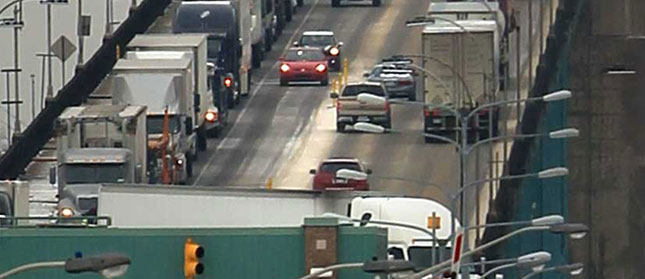
Quantifying what most cross-border carriers have known for well over a decade, a Stats Canada report released this month shows how much more expensive it’s become to move goods by truck across the Canada–US border since Sept. 11.
This study is based on the first data produced to estimate the costs associated with trucking goods across the border before and after 9/11.
From 1994 to 2000, it cost, on average, 16% more to move goods across the Canada–US border by truck than to move the same goods the same distance domestically. After 2000, the premium paid to cross the border rose steadily to 25% in 2005 and remained at about that level until 2009.
The report attributes the cost increases to a new security/regulatory regime in the wake of 9/11 as well border traffic delays and congestion as a result of the border thickening.
More from the report:
The two main factors in cross-border trucking costs are fixed costs per shipment of moving goods across the border and higher line-haul costs of trucking cargo over longer distances.
Delays at the border and other border compliance costs add to the fixed costs per shipment incurred by trucking firms. These fixed costs include facilities cost, insurance and terminal costs, that is, loading and unloading.
Differences in fuel prices or difficulties finding ‘backhauls,’ that is, cargo for a return shipment, can also add to the line-haul costs of shipping to and from the United States.
Whether these additional costs are imposed on the export or import leg of the cross-border journey depends on the balance of cross-border trips. The export leg bore these costs until about 2005 and, increasingly, the import leg thereafter.
In 2005, the premium on the export leg was 30.0%, while the premium on the import leg was 20.3%. By 2009, the premium on the export leg had fallen to 17.1% and risen on the import leg to 25.6%.
The extra cost associated with cross-border trucking added about 0.3% to the value of exported and imported goods, on average, from 1994 to 2000.
From 2005 to 2009, the extra costs of cross-border trucking added about 0.6%, on average, to the value of goods crossing the border. While these additional costs are relatively small on a percentage basis, their effect is larger for goods such as autos and auto parts that pass over the border several times as they move through the various stages of the production process.
Speaking to CBC, Bill Anderson, director of the University of Windsor’s Cross-Border Institute, said the increases impact Canadians’ competitive advantage by building extra costs into the supply chains making the cost of moving and purchasing goods more expensive.
Anderson said the newly planned Gordie Howe International Bridge in Windsor-Detroit should eventually help reduce those added costs by making relieving border congestion and making cross-border shipping more efficient.
For the full Stats Canada report click here.
